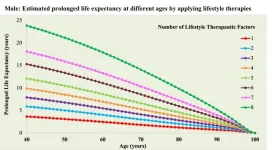(Press-News.org) An analysis of real-world data from more than 1.2 million patients from health systems in four geographically dispersed states -- Indiana, Oregon, Texas and Utah -- conducted by the U.S. Centers for Disease Control and Prevention’s VISION Network, has determined both the number of adults needed to be vaccinated to prevent one COVID-19 associated hospitalization and the number needed to be vaccinated to prevent one COVID-19 associated emergency department (ED) visit.
This study is one of the first, largest and most comprehensive studies to present clear measurement, by age groups, of how widespread vaccination needs to be to provide protection against serious and moderate disease in adults.
Preventing a hospitalization indicates that vaccination provided protection against severe disease. Preventing an ED visit indicates that vaccination provided protection against moderate disease.
“The number needed to be vaccinated or more technically, ‘number needed to vaccinate,’ comes from the related concept of ‘number needed to treat’ -- how many must be treated to avoid one bad outcome. One can think of number needed to treat or vaccinate as similar to how much gas you need, or how hard you need to push on the gas pedal to accelerate,” said study co-author Shaun Grannis, M.D., M.S., Regenstrief Institute Vice President for Data and Analytics and the Regenstrief Professor of Medical Informatics at Indiana University of School of Medicine. “Knowing the number of patients who need to be vaccinated is a way of measuring how effective the vaccine is. The lower the number of patients needed to be vaccinated, the more effective the vaccine. If we can prevent more hospitalizations with fewer vaccinations, that's important to know.
“Knowing the number of patients needed to be vaccinated helps us plan on the volume of vaccine needed and the type of awareness and education that we want to provide. This number informs decision-making processes by public health officials, vaccine producers, health systems and others.”
The study found that the number of patients needed to be vaccinated to prevent one COVID-19-associated hospitalization was higher than the number needed to vaccinate to prevent one COVID-19 associated ED visit, reflecting differences in outcome severity. These numbers were dependent on patient risk factors as well as local disease incidence.
The number needed to be vaccinated to prevent one COVID-19-associated hospitalization ranged from 44 to 615 (median was 205) individuals and was lower for adults aged 65 years or older and for those with underlying medical conditions. The number needed to be vaccinated decreased as the population became older because older individuals are more susceptible to the adverse effects of the virus and, therefore, the vaccine provides greater protection.
The number of patients needed to be vaccinated to prevent COVID-19-associated ED visits showed a different pattern because vaccines were more effective at preventing ED visits among younger adults than older ones. The median number needed to be vaccinated to prevent one ED visit ranged from 75 to 592 (median was 156) individuals.
Information from patients who had received either two or three mRNA vaccine doses was analyzed. None were immunocompromised. Data was from December 2021- February 2022, a period of Omicron BA.1 variant predominance.
“The reason why the number of patients needed to be vaccinated to prevent a COVID-19 related hospitalization is different from the number needed to prevent an ED (Emergency Department) visit is not fully understood, but it is likely because of how people seek healthcare. Many people, especially younger ones who lack health insurance or Medicare, are more likely to use the ED for primary healthcare. On the other hand, older people usually go to their regular doctor instead of going to the ED,” Dr. Grannis observed.
“Number needed to vaccinate with a COVID-19 booster to prevent a COVID-19-associated hospitalization during SARS-CoV-2 Omicron BA.1 variant predominance, December 2021-February 2022, VISION Network: a retrospective cohort study” is published in The Lancet Regional Health–Americas.
Regenstrief Institute co-authors, in addition to Dr. Grannis, are Interim Director of the Center for Biomedical Informatics Brian Dixon, PhD, MPA; William F. Fadel, PhD and Nimish R. Valvi, DrPH. Peter Embí, M.D., former president of the Regenstrief Institute and current affiliated scientist, is also a co-author.
All authors and affiliations:
Katherine Adams, MPH1; John J. Riddles, M.S.2; Elizabeth A. K. Rowley, DrPH2; Shaun J. Grannis, M.D., M.S.3,4; Manjusha Gaglani, MBBS5,6; Bruce Fireman, M.A.7; Emily Hartmann, MPP8; Allison L. Naleway, PhD9; Edward Stenehjem, M.D., MSc10; Alexandria Hughes, PhD2; Alexandra F. Dalton, PhD1; Karthik Natarajan, PhD11,12; Kristin Dascomb, M.D., PhD10; Chandni Raiyani, BDS, MPH5; Stephanie A. Irving, MHS9; Chantel Sloan-Aagard, PhD8,13; Anupam B. Kharbanda, M.D.14; Malini B. DeSilva, M.D., MPH15; Brian E. Dixon, PhD, MPA3,16; Toan C. Ong, PhD17; Jean Keller, M.S.2; Monica Dickerson, B.S.1; Nancy Grisel, MPP10; Kempapura Murthy, MBBS, MPH5; Juan Nanez, R.N., BSN8; William F. Fadel, PhD3,16; Sarah W. Ball, ScD, MPH2; Palak Patel, MBBS, MPH1; Julie Arndorfer, MPH10; Mufaddal Mamawala, MBBS, MPH5; Nimish R. Valvi, DrPH15; Margaret M. Dunne, MSc2; Eric P. Griggs, MPH1; Peter J. Embi, M.D., M.S.3,18; Mark G. Thompson, PhD1; Ruth Link-Gelles, PhD1; and Mark W. Tenforde, M.D., PhD1.
1Centers for Disease Control and Prevention COVID-19 Response Team, Atlanta, Georgia; 2Westat, Rockville, Maryland; 3Center for Biomedical Informatics, Regenstrief Institute, Indianapolis, Indiana; 4School of Medicine, Indiana University, Indianapolis, Indiana; 5Baylor Scott & White Health, Temple, Texas; 6Texas A&M University College of Medicine, Temple, Texas;7Kaiser Permanente Vaccine Study Center, Kaiser Permanente Northern California Division of Research, Oakland; 8Paso del Norte Health Information Exchange (PHIX), El Paso, Texas; 9Center for Health Research, Kaiser Permanente Center for Health Research, Portland, Oregon; 10Division of Infectious Diseases and Clinical Epidemiology, Intermountain Healthcare, Salt Lake City, Utah; 11Department of Biomedical Informatics, Columbia University Irving Medical Center, New York, New York; 12New York-Presbyterian Hospital, New York; 13Brigham Young University Department of Public Health, Provo, Utah; 14Children's Minnesota, Minneapolis, Minnesota; 15HealthPartners Institute, Minneapolis, Minnesota; 16Fairbanks School of Public Health, Indiana University, Indianapolis; 17School of Medicine, University of Colorado Anschutz Medical Campus, Aurora; and 18Vanderbilt University Medical Center, Nashville, Tennessee.
About Shaun Grannis, M.D., M.S.
In addition to his role as the vice president for data and analytics at Regenstrief Institute, Shaun Grannis, M.D., M.S., holds the Regenstrief Chair in Medical Informatics and is a professor of family medicine at Indiana University School of Medicine.
About Regenstrief Institute
Founded in 1969 in Indianapolis, the Regenstrief Institute is a local, national and global leader dedicated to a world where better information empowers people to end disease and realize true health. A key research partner to Indiana University, Regenstrief and its research scientists are responsible for a growing number of major healthcare innovations and studies. Examples range from the development of global health information technology standards that enable the use and interoperability of electronic health records to improving patient-physician communications, to creating models of care that inform practice and improve the lives of patients around the globe.
Sam Regenstrief, a nationally successful entrepreneur from Connersville, Indiana, founded the institute with the goal of making healthcare more efficient and accessible for everyone. His vision continues to guide the institute’s research mission.
About IU School of Medicine
IU School of Medicine is the largest medical school in the U.S. and is annually ranked among the top medical schools in the nation by U.S. News & World Report. The school offers high-quality medical education, access to leading medical research and rich campus life in nine Indiana cities, including rural and urban locations consistently recognized for livability.
END
Large study determines number needed to be vaccinated to prevent COVID-19 hospitalizations and ED visits
Analysis provides real-world measurement of benefit of vaccination including booster
2023-07-24
ELSE PRESS RELEASES FROM THIS DATE:
These eight habits could lengthen your life by decades
2023-07-24
A new study involving over 700,000 U.S. veterans reports that people who adopt eight healthy lifestyle habits by middle age can expect to live substantially longer than those with few or none of these habits. The eight habits are: being physically active, being free from opioid addiction, not smoking, managing stress, having a good diet, not regularly binge drinking, having good sleep hygiene, and having positive social relationships.
According to the results, men who have all eight habits at age 40 would be predicted to live an average of 24 years longer than men with none of these habits. For women, having all eight healthy lifestyle factors ...
Nutritional content of most milk alternatives doesn’t measure up to cow’s milk
2023-07-24
More people are drinking milk alternatives made from plant sources such as oats, soy, or almonds, but do plant-based products deliver the same nutrition as cow’s milk? Results from a new study suggest that most don’t.
Cow’s milk is an important source of calcium and vitamin D, both of which are identified in the 2020-2025 Dietary Guidelines for Americans as nutrients of public health concern for underconsumption. Cow’s milk is also a major source of protein in the American diet.
To assess how the nutritional content of plant-based milk alternatives compares to that of cow’s milk, researchers examined more than ...
How people judge anti-vaxxers who die from COVID-19
2023-07-24
COLUMBUS, Ohio – When people who publicly reject COVID-19 vaccines later die from the disease, observers have complex reactions to their fates, a new study suggests.
While very few rejoice in the deaths of anti-vaxxers, some people believe those who are dogmatic against vaccines are deserving of worse outcomes – and that reaction is related to the political party affiliation and vaccination status of the person evaluating the anti-vaxxer.
Democrats and those who were vaccinated were more likely than Republicans and the unvaccinated to think anti-vaxxers who died got what they deserved ...
Robot preachers get less respect, fewer donations
2023-07-24
As artificial intelligence expands across more professions, robot preachers and AI programs offer new means of sharing religious beliefs, but they may undermine credibility and reduce donations for religious groups that rely on them, according to research published by the American Psychological Association.
“It seems like robots take over more occupations every year, but I wouldn’t be so sure that religious leaders will ever be fully automated because religious leaders need credibility, and robots aren’t credible,” said lead researcher Joshua Conrad Jackson, PhD, an assistant professor at the University of ...
Plastic surgery goes to the movies: Journal of Craniofacial Surgery looks at facial disfigurement
2023-07-24
July 24, 2023 – Characters with facial disfigurement have long been a recurring theme in films. Their characteristics and outcomes lend insights into perceptions of facial deformities and the effects of plastic surgery, reports a study in The Journal of Craniofacial Surgery under the guidance of Editor-in-Chief Mutaz B. Habal, MD, FRCS, FACS of Tampa, Florida. The journal is published in the Lippincott portfolio by Wolters Kluwer.
Movie characters who undergo successful plastic surgery to improve their facial appearance are more likely to have happy endings, according to the new research by Young Suk Kim, BA, and Kun Hwang, MD, PhD, of Armed Forces ...
Opting for olive oil could boost brain health
2023-07-24
A new study suggests that incorporating olive oil into your diet could help reduce the risk of dying from dementia. As many countries face rising rates of Alzheimer’s disease and other forms of dementia, the study offers hope that healthy lifestyle factors such as diet can help to prevent or slow the progression of these devastating conditions.
“Our study reinforces dietary guidelines recommending vegetable oils such as olive oil and suggests that these recommendations not only support heart health but potentially brain health, as well,” said Anne-Julie Tessier, RD, PhD, a postdoctoral fellow at the Harvard T.H. ...
Upping your intake of omega-3s may help protect your hearing
2023-07-24
Researchers report that blood levels of the omega-3 fatty acid docosahexaenoic acid (DHA) were inversely correlated with hearing difficulty in a new population-based cross-sectional study. Middle-aged and older adults with higher DHA levels were 8-20% less likely to report age-related hearing issues than those with lower DHA levels.
“Higher DHA levels have previously been found to be associated with a lower risk of heart disease, cognitive impairment, and death. Our study extends these findings to suggest a role for DHA in maintaining ...
What is the best dieting strategy for people with type 2 diabetes?
2023-07-24
Losing weight is often a goal for people with type 2 diabetes, which is strongly associated with being overweight or obese. However, it hasn’t been clear what dieting strategy works best for people with this metabolic disorder.
A new randomized controlled study of people with type 2 diabetes showed that study participants who restricted eating to between noon and 8 p.m. daily lost more weight than those who reduced their overall calorie intake by counting calories. Both dieting strategies produced similar improvements in blood sugar levels.
“Many people find counting calories very hard to stick to in the long term, ...
Wormlike animals are first amphibians shown to pass microbes to their offspring
2023-07-24
Caecilians are an elusive type of amphibian that primarily live underground and look like a cross between a worm and a snake. One of the few things that is known about caecilians is their unique method for feeding their young. Mothers produce a special layer of fatty skin tissue, which juvenile caecilians tear off with baby teeth that evolved specifically for that purpose.
A new study shows that skin-feeding does more than provide nutrients for young caecilians. It also helps the mother pass microbes from her skin and gut down to her young, inoculating them to jump-start a healthy ...
Image-guided adaptive radiation treatments reduce short-term side effects for patients with prostate cancer
2023-07-24
A technique that uses imaging technology as a guide can make radiation therapy safer for patients with prostate cancer by helping clinicians accurately aim radiation beams at the prostate while avoiding nearby tissue in the bladder, urethra, and rectum. That is the finding of a thorough analysis of all published clinical trials of the technique, called magnetic resonance–guided daily adaptive stereotactic body radiotherapy (MRg-A-SBRT). The analysis is published by Wiley online in CANCER, a peer-reviewed journal of the American Cancer Society.
By providing detailed images, MRg-A-SBRT can be used to adjust a patient’s radiation plan every ...
LAST 30 PRESS RELEASES:
Making lighter work of calculating fluid and heat flow
Normalizing blood sugar can halve heart attack risk
Lowering blood sugar cuts heart attack risk in people with prediabetes
Study links genetic variants to risk of blinding eye disease in premature infants
Non-opioid ‘pain sponge’ therapy halts cartilage degeneration and relieves chronic pain
AI can pick up cultural values by mimicking how kids learn
China’s ecological redlines offer fast track to 30 x 30 global conservation goal
Invisible indoor threats: emerging household contaminants and their growing risks to human health
Adding antibody treatment to chemo boosts outcomes for children with rare cancer
Germline pathogenic variants among women without a history of breast cancer
Tanning beds triple melanoma risk, potentially causing broad DNA damage
Unique bond identified as key to viral infection speed
Indoor tanning makes youthful skin much older on a genetic level
Mouse model sheds new light on the causes and potential solutions to human GI problems linked to muscular dystrophy
The Journal of Nuclear Medicine ahead-of-print tip sheet: December 12, 2025
Smarter tools for peering into the microscopic world
Applications open for funding to conduct research in the Kinsey Institute archives
Global measure underestimates the severity of food insecurity
Child survivors of critical illness are missing out on timely follow up care
Risk-based vs annual breast cancer screening / the WISDOM randomized clinical trial
University of Toronto launches Electric Vehicle Innovation Ontario to accelerate advanced EV technologies and build Canada’s innovation advantage
Early relapse predicts poor outcomes in aggressive blood cancer
American College of Lifestyle Medicine applauds two CMS models aligned with lifestyle medicine practice and reimbursement
Clinical trial finds cannabis use not a barrier to quitting nicotine vaping
Supplemental nutrition assistance program policies and food insecurity
Switching immune cells to “night mode” could limit damage after a heart attack, study suggests
URI-based Global RIghts Project report spotlights continued troubling trends in worldwide inhumane treatment
Neutrophils are less aggressive at night, explaining why nighttime heart attacks cause less damage than daytime events
Menopausal hormone therapy may not pose breast cancer risk for women with BRCA mutations
Mobile health tool may improve quality of life for adolescent and young adult breast cancer survivors
[Press-News.org] Large study determines number needed to be vaccinated to prevent COVID-19 hospitalizations and ED visitsAnalysis provides real-world measurement of benefit of vaccination including booster


